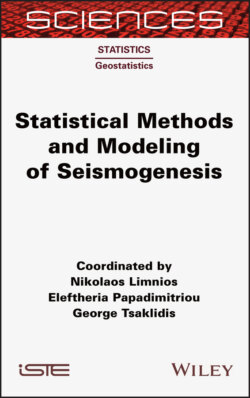Читать книгу Statistical Methods and Modeling of Seismogenesis - Eleftheria Papadimitriou - Страница 38
2.6. Appendix 2: Outline of the simulation program
ОглавлениеPurpose: creating a synthetic earthquake catalog in a seismogenic region described by a rectangular fault, divided into segments of different slip rate. The fault geometry is described by the total along-strike length of the fault system (L), the length and the tectonic slip rate of each segment, a uniform down-dip width (W) and the cell length (a) and width (b). Assuming a stress drop Δσ = 3.3 106 Pa, the slip, seismic moment and magnitude of an earthquake on a single cell is computed (see the appendix in section 2.5). The following parameters are used by the algorithm:
– the average initial stress budget on the fault;
– the variability of the initial stress budget on each cell (e.g. 5%);
– the stress threshold necessary for event nucleation (stress_thresh);
– the value of the strength reduction coefficient (strength_red_coeff, S-R) (e.g. 0.05) ; zero means no strength reduction;
– the multiplying factor to be used for discouraging the propagation of the rupture on the strike direction (aspect_ratio, A-R) (e.g. 2.5); infinity means no limitation at all;
– the time step of the simulations;
– the total duration of the synthetic catalog;
– a warm up time before the beginning of the catalog.
An initial stress budget is randomly assigned to every cell. The first nucleation point is selected as the cell where the largest stress budget is assigned, if it exceeds the minimum stress budget required for event nucleation. Otherwise, the program proceeds by one time step, adding the tectonic stress rate for one time step to every cell, and the search for the nucleation point is started again. If the nucleation cell is found, the stress budget on the nucleation cell is decreased by a stress drop Δσ = 3.3 · 106 Pa. The stress budget on the other cells is increased on the basis of the stress transfer computed on each cell:
where
is the seismic moment released by the rupture on a single cell (see Console and Catalli 2006) and dist is the distance in km between the centers of two cells.
1) the procedure for the propagation of the rupture on the neighboring cells is started;
2) set the number of ruptured cells of the event (Ncell_ev) to 1;
3) find the smallest of Ncell_ev and · aspect_ratio) and call it Ncell_min;
4) compute
5) starting from 1 to Ncell_ev, find the cell with the largest stress budget among all those already ruptured in the event with the addition of all bordering those already ruptured;
6) the largest stess budget exceeds the threshold value stress_thresh diminished by Strength_red?
7) if not, go to (2), if yes, go on;
8) decrease the stress budget of the ruptured cell by a value equal to Δσ;
9) increase the value of the stress budget of any other cell by ΔCFF computed as described above for the nucleation rupture;
10) increase Ncell_ev by 1;
11) go to (1);
12) store the event parameters;
13) the time, the event sequential number and other parameters of the event are written on the output file.
A cell can be ruptured more than once in the same event. The program proceeds by one time step, adding the tectonic slip rate for one time step to every cell, and the search for a new nucleation point starts again. The process stops when the time assigned for the output catalog is exceeded.
